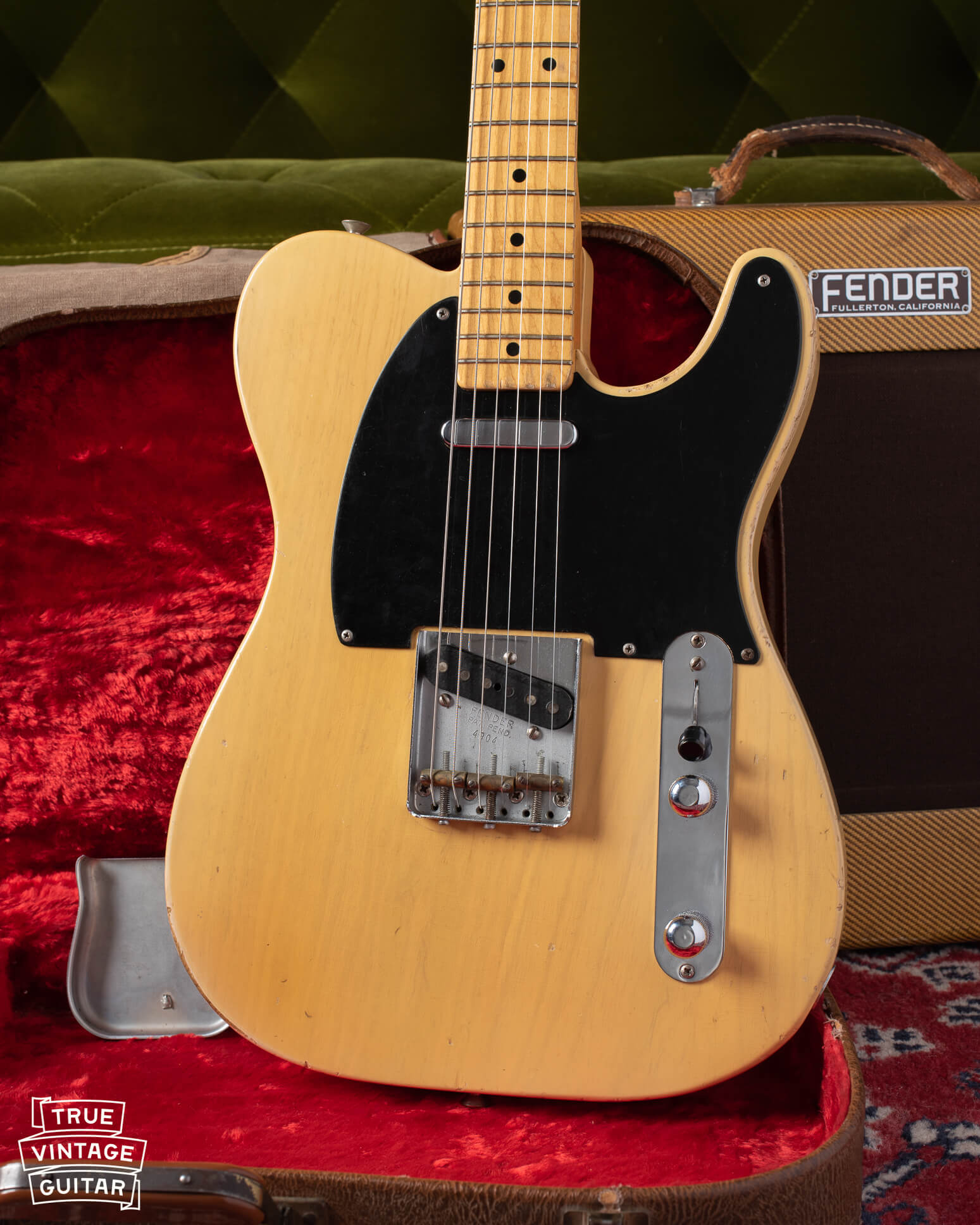This amazingly clean 1964 Gibson SG Standard just breezed through the shop after I purchased it from a luthier outside of Montreal, Canada! This nearly perfect example of the SG Standard is an excellent specimen from one of the best years of the model. As I looked at the listing pictures, I nearly thought that the pickup covers were chrome because of the nickel finish is so clean and unoxidized. As I plugged it in to play it for the first time, the notes jumped out of the amplifier with both a cutting brightness and rich fullness. This is one of the finest vintage guitars to come through my shop this year.
Looking to sell? I buy 1964 Gibson SG Standards: Sell a Gibson

Historical Context of the 1964 Gibson SG Standard
The guitar that became known as the SG Standard was originally introduced by Gibson in 1961 as the "Les Paul Standard". By the end of 1960, the Sunburst and single cutaway Les Paul Standard's sales were less than satisfying to the bean counters at Gibson's parent company (CMI), so a model refresh was due. No doubt Gibson was eyeing its competition from Fullerton, CA with its thinner and lighter guitars when the slab Mahogany body with contoured edges was pitched. The vibrato tailpiece was deemed standard equipment on this new body style who's name was not yet "SG". The shape of this new body style seems revolutionary to Gibson, but it may owe some of its styling to the double neck guitars made by Gibson from 1958 until 1960.
By the middle of 1963, Les Paul's popularity sagged compared to the early years of the 1950s when he and Mary Ford's television appearances were enthralling viewers with this new sound. The marriage between the two was strained, and the contract they signed with Gibson in 1952 had an interesting stipulation. Because of their high tax bracket in the 1950s, Les Paul and Mary Ford were not to be compensated from Gibson until the end of the signature deal (Source: Gil Hembree, Gibson Guitars: Ted McCarty's Golden Era 1948–1966, p. 82). Les and Mary were to split the proceeds 50/50. The signature was likely dropped from the model for both of these reasons, but the latter seems more significant to me.
Apart from the new "SG" model name, the most significant update from the previous years was the Gibson Deluxe Vibrola tailpiece, often call the "Lyre" vibrola by collectors because of the fancy engraving on the front cover. The previous "side pull" vibrola was known to cause tuning instability which troubled players. The new style was much simpler and is preferred today by players.
Design Features and Technical Specifications
Unlike the symmetrically double horned Doubleneck Gibson guitars from the few years before, The SG Standard features a solid slab Mahogany body and Mahogany neck. The body is almost half the thickness of the previous single cut Standards which yields a significantly weaker neck joint. The early Les Paul marked SG Standards suffered from neck to body joint cracks, but this weakness was largely addressed by 1964. The Humbucking pickups in '64 were identical to those made in 1961, but the stickers now bear a patent number in place of the desirable PATENT APPLIED FOR stickers. But the patent number shown on the pickups - US Patent number 2,737,842 - was granted to Lester W Polfuss for the combined bridge and tailpiece on the first version of the Les Paul Model from 1952!

The neck width and profile is unsurprising for Gibson guitars made in 1964: standard 1 11/16" nut width, 0.82" deep at the first fret, and 0.97" deep at the 12th fret. The 1 11/16" nut width is referred to by guitar players as the "Wide Neck", but only in contrast to the skinny neck profiles Gibson made starting in mid 1965 throughout the rest of the 1960s (for certain models). The 0.82" to 0.97" neck profile measurements translate to a slim (but not blade) 1st fret area that tapers up to fat (but not baseball bat) profile up at the 12th fret. This happens to be nearly identical to the 1960 Les Paul Standard neck profiles made in the 0_1xxx-0_2xxx range most collectors refer to as "brackish". Not as fat as '59, but not super slim like most 1960 Bursts.
What really blew me away about this '64 SG Standard was the condition of both the nickel hardware and the Cherry Red original finish. 1964 SG Standard should have nickel finished hardware which is prone to oxidizing to a grey color with sort of textured feel. It's much different from the mirror-like chrome finish Gibson used beginning in 1965. The luthier's pictures of this guitar were very clear, but the humbucking pickup covers looked very shiny like chrome, not like the nickel I'm used to. I checked the serial number multiple times: a six digit number beginning with 178xxx. The only option for this number was 1964, although Gibson serial numbers can be tricky sometimes. I rolled the dice because the rest of the guitar was so clean. When it arrived, I could see that the metal finish was nickel, but it was very clean and not oxidized except for on the very edge of the covers.
Playability and Tone
The playability and tone of this '64 SG Standard surpassed my expectations in at least two ways: the notes jumped out of the amplifier with a pop that surprised me and the were easy to fret up and down the fretboard. The patent number pickups sounded bright but were easily tamable with a flick of the tone knobs. I drew from Joe Bonamassa's insight about dialing in the tone knobs on an SG: start at about 50% on both tone knobs and go from there. The "pop" of the notes that surprised me on this guitar is something I'm more familiar with on Maple capped Les Pauls.
Since this example was made in 1964, the neck profile was a classic slim-taper style that I felt perfectly at home with. The neck depth at the first fret measured exactly. 0.80" deep - a classic slim neck in the cowboy chord area. But it tapered up quickly to about 0.98" deep at the 12th fret - not quite baseball bat, but getting much closer to it. My experience with this neck profile is that it won't stick out in either direction. You'll feel right at home no matter which profile you're used to.
Since this guitar had just come from a luthier, the set up was already dialied in very nicely. The original wide frets were nearly unplayed so fret wear was not an issue. The action was low across the board and I didn't notice any dip in the board at the higher frets. It was a dream to play and hear.
1964 Gibson SG Standard Authentication
While Gibson serial numbers can be difficult to decipher and often inconsistent, the true 1964 Gibson SG Standards do have a typical serial number range. They can be found only in a die stamped style (picture below) with no "MADE IN USA" stamp underneath. Most '64s will have a six digit serial number in the 140,000s, or 170,000s - 250,000 range. For more on Gibson serial numbers, check out the Gibson Serial Number Lookup.

Collector Appeal and Market Value
1964 is a special year for guitar players and collectors looking for an SG Standard. Collectors and players will know that every 1964 SG Standard has a wide neck (1 11/16" at the nut), nickel hardware, and a more stable neck joint than earlier versions. It represents the last full year of all the best features for the SG model. But since it's not as collectible as an earlier year like 1961 or 1962, they're typically not as expensive. It's a great year to look for if you're only going to have one vintage SG guitar.
The most significant aspect to look for when evaluating a vintage SG Standard is the neck joint and headstock. An issue at either of these two areas will result in about a 50% discount in value compared to a similar example with no issues. Both the headstock and the neck joint on the 1960s SGs are weaker than those of other models, so be sure to check both areas for repairs when buying a vintage SG. If you're looking for help with the value of a vintage Gibson, check out my Vintage Guitar Appraisal page.
Looking to sell?
Feel free to reach out if you're thinking of selling a 1964 Gibson SG Standard: Sell a Gibson. As a guitar collector and dealer, I'm always looking to buy the nicest examples of old Gibson SG guitars. You can contact me at that link if you're thinking about sell.



